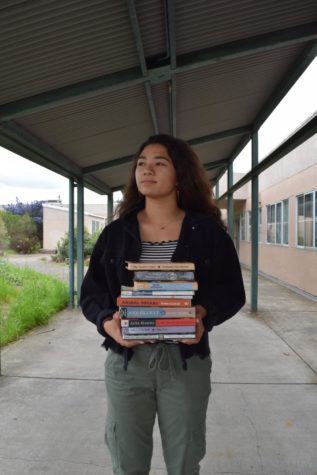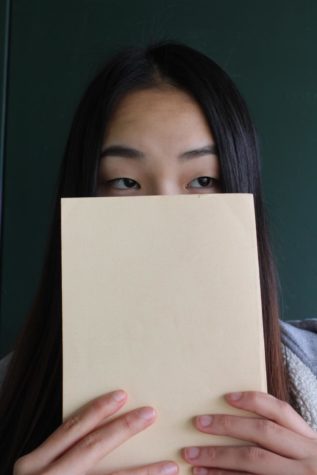Women’s Representation in Curriculum
April 5, 2019
The editorial board staff explores the issue of women’s representation in academia and academic literature, especially that which is presented to students at school.

Reporter Taya Llapitan holds some staples of the school’s literature curriculum.
These unsigned editorials are written by the members of the editorial board: Alice Antony, Nellely Azpeitia, Emet Beckman, Kayla Briceño, Celeste Chavez, Lauren Doran, Sue Jacob, Taya Llapitan, Cash Martinez, Alejandro Paredes, Sydney Pearce, Aalyna Silva, Kevin Sittner, Natasha Thomas, Kaitlyn Wong, and Grace Yarrow. However, the ideas presented do not necessarily reflect the views of The Gaucho Gazette staff as a whole.
Accurate Representation
Within a usual classroom setting on campus, teachers emphasize the importance of women and their roles in society by integrating it in their teaching curriculums, which have become significantly more diverse and inclusive of gender minorities. Although men seem to have always dominated the spotlight for centuries in historical texts, that has not restricted teachers from adequately dedicating time to value the significance of “herstory” within social studies and literature. The English and Social Studies departments accurately calibrate respect to both men and women — making diversity one of the main focuses in their respective teachings.
The visibility of women throughout English courses has undoubtedly become more prevalent than ever before with students studying famous novels consisting of strong female protagonists such as “Their Eyes Were Watching God,” “The Scarlet Letter,” “The Awakening,” “Pride and Prejudice,” “The Odyssey,” “The Glass Menagerie,” “To Kill a Mockingbird,” and more. While shedding light upon serious controversial topics like racism and sexism, students are exposed to narratives from when women were ruled and oppressed by a hegemony driven by males. Take, for example, “Their Eyes Were Watching God,” in which Janie, a black woman living in the South during the twentieth century, encounters abusive relationships where she is manipulated into allowing herself to be mistreated by her lovers during the course of her life, all while finding happiness in the process. These books cover a plethora of social and political themes such that are often topics of discussion for Socratic seminars: gender roles, inequality, individuality, conformity, marriage, etc.
The English and Social Studies departments accurately calibrate respect to both men and women — making diversity one of the main focuses in their respective teachings.
With respect to understanding the perspectives from women, English teacher Cassandra Bacho instructs her AP Literature and Composition students to analyze novels like “Things Fall Apart” from a feminist perspective. This strategy is implemented to strengthen students’ philosophical skills at examining and pointing out cultural customs and whether there are certain ideas within a culture essentially perpetuating inequality of the sexes or reinforcing male dominance. This hands-on evaluation through a feminist lens can help provide a historical background to the women’s rights movement and on the topic of women’s issues, effectively expanding the knowledge and sensitivity of students to these situations. These lessons also incorporate current social and political issues into the themes of the content, which helps students relate to their education by making connections between life and literature. Not only does this method introduce students to a feminist mindset, but it also teaches students ways that they can be more critical of the media they consume.
Although diversity is something that must constantly be worked on and improved by society, the inclusion of women in American education, both in English and social studies, is undeniably more prevalent today than ever before.
Inaccurate Representation
Throughout educational history, the role of women in various subjects has been consistently overlooked and misrepresented. Despite apparent efforts to make high school curriculum more inclusive of the various roles and impacts of women, textbooks and lessons continue to be void of appropriate representation of women and fail to include a proper display of their differing perspectives.
The absence and misrepresentation of women can be seen in multiple subjects, predominantly history and English courses. For example, in the A.P. U.S. History course, the College Board covers the Women’s Suffrage Movement and Women’s Rights Movement in their objectives but fails to extend much further than a small insignificant portion of the year-long course. In the world history classes, the textbook which is incorporated into the lesson plans, “World History: Patterns of Interaction,” women are referenced less than ten times in its entirety.
Although each teacher has their preference, ability, and knowledge to try to incorporate multiple perspectives, many classes fail to reflect the complete historical picture including the female perspective, apart from the material that is given to them. This lack of initiative in bringing outside voices and influencers into the curriculum leaves the information taught to be incomplete and distorted. According to journalist Elizabeth Weingarten from The Atlantic, in 1971, research quantified how underrepresented women were in U.S. History high school textbooks, revealing that there was more textbook space given to the length of women’s skirts than to the suffrage movement.
Within textbooks alone, there remains a disparity between representation of women and men. In the second-largest school district in the nation, the Los Angeles Unified School District (LAUSD), the authors for the language arts textbooks for eighth, ninth, and tenth grades were less than 30 percent female. Meanwhile, the LAUSD’s population is comprised of 52 percent females.
While female representation, defined purely in a quantitative sense, fairs better in assigned English texts than in history books; the problem regarding the depiction of women in literature is that they are primarily written as two dimensional supporting characters in traditional novels. And even though the amount of women mentioned in core English books is more than those in historical text books, the numbers still put them well within the minority.

Even in children’s books, a study led by Janice McCabe, a professor of sociology at Florida State University, found that males are central characters in 57 percent of children’s books published each year, with just 31 percent having female central characters. Male animals are central characters in 23 percent of books per year, the study found, while female animals star in only 7.5 percent.
Although cases of writings about women’s issues are present occasionally in school curriculum, these rarities are absolutely not representative of the presence of these subjects in real life. Changes must be made so that women can have a space in literature and academic works to exhibit their unique struggles and strengths.